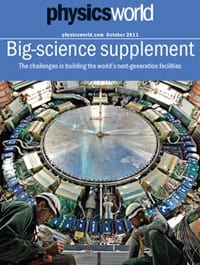By Michael Banks
The world may be in the midst of an economic downturn, yet that has not stopped scientists from planning a whole host of next-generation “big-science” facilities as well as governments pledging billions of euros to build them over the next 10–15 years.
From the ITER fusion experiment currently under construction in Cadarache, France, to the European Spallation Source in Lund, Sweden, the coming decade look to be a boon for researchers seeking new subatomic particles that exist for only a fraction of a second or studying events that occur on the femtosecond timescale.

In a special supplement accompanying the October issue of Physics World and available to download here, we take a look at the specific challenges of building and designing these facilities – from how to get them funded to the engineering and scientific issues that have to be met before construction can begin.
One facility that certainly fits the big-science mould is the Large Hadron Collider (LHC) at the CERN particle-physics lab near Geneva. With the LHC now on track hunting for new physics, researchers at CERN are not resting on their laurels but planning a major upgrade to their accelerator and detectors that will produce and track ever more collisions.
Indeed, detecting faster processes is also an integral part of the planned SuperB particle-physics experiment to be built near Rome by 2016, which will study the decay of quarks. As one article in the supplement explains, it may employ CMOS detector technology to take images at a rate of two million per second of the debris caused by particle collisions.
Other highlights in the supplement include the challenges that lie in store for the European X-ray Free Electron Laser in Germany – a new facility to detect ultrafast processes such as chemical reactions – that will use pioneering superconducting magnet technology to enable it to take “movies” of chemical reactions happening in real time. Magnets are also the name of the game at ITER, which will use thousands of tonnes of coils to hold a 150 million Kelvin plasma in place.
Big science also means big lasers and they are set to play a key role in a German-based collaboration using them to accelerate protons for medical application as well as at the European Extremely Large Telescope, planned for Chile, which will use lasers as an integral part of its novel approach to correcting for atmospheric distortions of light from distant objects.
I hope this supplement gives you a glimpse of the challenges that researchers face to surpass the possibilities of existing technology and make next-generation facilities happen. Download it here.


